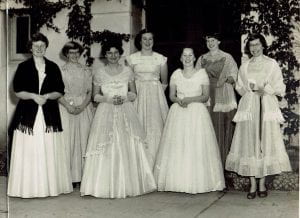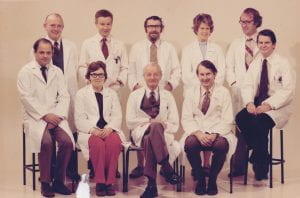This biography is based on an interview with Helen Angus in 2019 for the Early Medical Women of New Zealand Project. The interviewer was Nora Lynch.
Left to right: Patricia Buckfield, Helen Bichan (nee Simpson), Patricia Wood (nee Houghton), Anne Gillies, Pamela Jones (nee Brown), Helen Angus, Jean Bryant (nee Fyfe)
Helen Angus was born in Hastings in 1934. During her childhood years, her family moved around the east coast of New Zealand’s North Island. She completed her secondary school studies at Gisborne High, a co-ed school, where she chose to study science and maths. Helen’s parents were proud of their daughter’s achievements, particularly as they had had limited education opportunities themselves.
Helen was a conscientious student who was awarded girl dux at the end of her secondary schooling, and because of her scholastic achievements she considered becoming a doctor.
“It must have been about fifth form that I’d decided I would do medicine at university. And nobody said, “no you can’t” or “it’s too expensive”.
“I must have been fairly dependent on my parents for financial assistance during my time in Dunedin. While boys could get lucrative jobs in the freezing works or on the wharves in the long holidays, there were fewer opportunities for girls and I worked as a maternity nurse aide, earning some money but not enough to pay for all my expenses. I also had a government boarding bursary”.
Helen successfully completed her medical intermediate year and was accepted into medical school in 1954, with less than ten other women. Medical school was an enjoyable, happy time, and Helen recalls biking everywhere, playing the piano, and socialising with her friends. She lived at St Margaret’s College with girls who were doing Bachelor of Arts rather than medicine, and they remained lifelong friends. Helen doesn’t recall any discrimination against women in her medical school years. She graduated from Otago University in 1958, along with four other women.
Midway through her second house surgeon year Helen suddenly realised that at the end of the year she would have to decide what she was going to do next. After going through the options and removing those that she didn’t like, including general practice, surgery, and paediatrics, she realised that pathology appealed to her. The only pathology registrar post in Auckland was already filled so she decided to take a job as a pathology registrar in Christchurch Hospital in 1961. In 1967 she passed the examination to become a Fellow of the Royal College of Pathologists of Australasia and subsequently became a consultant anatomical pathologist with the Canterbury Area Health Board. This role required her to complete autopsies, examine operation specimens and biopsies and report on their histology, and signing off the typed reports.
In the early 1970s Helen spent six months in America and the UK visiting different laboratories and anatomical pathology consultants, broadening her experience.
“When I came back, I think the main thing I’d learnt was that the standards in New Zealand were as good as they were there elsewhere. Which was useful because it did mean that if our consultants challenged what we were saying and our diagnoses, at least we knew that we were as good as those overseas.”
Helen was well known for her diagnostic skills, and sometimes acted as a consultant for other laboratories, including the Godfrey Laboratory—the forerunner of MedLab. Later in the 1970s, she was awarded a Cancer Society Travelling Fellowship which funded her travel to the USA for a course on malignant lymphomas, in which she had developed an interest, and when she returned, she passed on the new information she had gleaned to New Zealand pathologists.
Although modest about her skills, Helen was suited to her profession and respected by other clinicians. Her aptitude for English allowed her to effectively communicate her findings in her reports.
“I think I got on okay with the surgeons, it always used to surprise me sometimes that they actually did listen to what I was saying.”
Although her main clinical work was spent in the laboratory, Helen also applied her specialist skills to the wider field of pathology. During the 1980s, she acted as an examiner for the College of Pathologists of Australasia, and occasionally was asked to audit the work of colleagues in other centres. She was also a Clinical Lecturer at the Christchurch campus of the Otago Medical School, teaching medical students in pathology.
Back row (left to right): Pat Kelleher, Mike Beard, Laurie Treadgold, Helen Angus, Robin Fraser
Front row (left to right): Claude Andre, Joan Faoagali (nee Wilson), [Unknown], Roy McGiver, Jack Hamer
In her own time, Helen was a member of the Royal Christchurch Musical Society choir, which involved weekly practices, and trips to Australia for concerts. She also played Bridge regularly, learnt to use a knitting machine, and completed a two-year course in embroidery.
Helen was never aware of any gender discrimination against her personally during her medical career. However, compared to her early years training in Auckland, she noticed that the medical staff employed in Christchurch Hospital in the 1960s were almost exclusively male, and preferably educated in Christchurch’s elite secondary schools. However, during her career, the number of female staff increased, to include more women students, house surgeons, and consultants.
Helen can see the pros and cons of having a partner and children and admires other women who managed to achieve this while balancing their workload, gaining post-graduate qualifications, and home responsibilities.
Helen retired on her 63rd birthday and had to adapt to not feeling needed any more. However, retirement has given her the opportunity to spend more time doing the things she enjoys.
“If I had my time again, I’d still choose medicine, and anatomical pathology as my specialty”.



